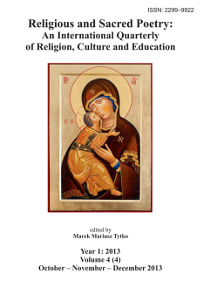Религиозные мотивы в лирике лагерников ГУЛАГ-а
Religious Motifs in the Lyrics of the Inmates of the Gulag
Author(s): Nadiya Georgijivna KoloshukPublished by: Fundacja Naukowa Katolików »Eschaton«
Keywords: Religious Motifs; the Lyrics of the Inmates of the Gulag
Summary/Abstract: Camp poetry, which belongs to the underground branch of Soviet culture, indicates spiritual resistance to the totalitarian regime and underlines the fact that the regime didn’t manage to uproot the spiritual and godlike qualities in human beings. The topicality of the research consists in investigating the social and cultural meanings of Gulag poetry, and the novelty of the research lies in the choice of the material which has not been analyzed and critically commented upon before. Methodologically, the study makes use of the classical methods of literary criticism ( drawing on elements of literary history, historical comparative studies, typology and biography) and modern approaches of receptive aesthetics, hermeneutics, structuralist and semiotical analysis. The purpose of the research is a presentation and examination of religious motifs in the Ukrainian and Russian camp lyrics included in a few anthologies which are valuable for the researcher because they contain poetic material so far rarely dealt with critically. Main results. Camp poetry spread in the camp itself, then passed out of the camp, was revived from oblivion outside the camp and had been kept secret, passed on verbally for many years by many people. The evidence of the unique peculiarities of its existence shows that it had particular functions and meaning which refer only to the sphere of the sacred, being linked to prayer, amulet, ritual, myth. Prayer, psalm, lamentation and song became the most useful generic forms. Poetry was, literally, a miracle of salvation – many authors who survived the camp can testify to that (e.g. Ivan Hnatyuk). Camp poetry is saturated with religious motifs expressed in the images that are symbolic of Christianity: the Cross, the Crucifix, Christ’s sorrows, the chalice of suffering, Calvary. The motifs also include martyr’s death, unbroken spirit, God’s miracle, prayer about salvation, Christmas, absolution of sins and Resurrection. In comparison with the literature published officially i.e. ‘continental’ literature, the lyrics of “the Gulag Archipelago” demonstrate a greatly increased amount of such religious symbols and images. This list of religious motifs which have been used by poets-inmates is incomplete: there are a number of religious motifs which have not been included in the present research. There is no doubt that a further study of the camp heritage is called for. The opinions of aesthetically low poetic value of camp lyrics are insubstantial. The lyrics’ distinctive features are simplicity, naivety of the style, prevalence of classical means of versification as poems were destined for verbal perception and remembering. But simplicity is inseparable from terse clearness and boldness of statement, which gives many poems an aphoristic character. Many camp poets didn’t need formal and stylistic experiments to express their meaning and the works of the Ukrainian poets of the postwar generation of the 1960s
Journal: Religious and Sacred Poetry: An International Quarterly of Religion, Culture and Education
- Issue Year: 2013
- Issue No: 4
- Page Range: 155-186
- Page Count: 32

